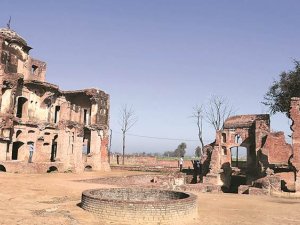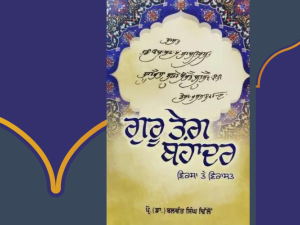Sindhi Hindus and their reverence to Guru Nanak, founder of Sikh religion and Guru Granth Sahib, the religious book of Sikhs which is treaty as 'Living Guru' is fascinating. To understand the history behind it, I decide the research the Hindus living in Sindh, Pakistan.
It is home to 93% of Hindus in Pakistan. Authorities estimate that there are 3.5 million Hindus in Pakistan. The last census in Pakistan was conducted in 1998 and it recorded 2.3 million Hindus. The population figures based in religion for census conducted in 2016 ARE still awaited. The Pakistan Hindu Council, however, gives a much bigger estimate of 8 million. This cannot be verified from other sources.
This is a short video of Bhai Ajay Kumar & Bhai Vijay Singh of Gambat city (district Khairpur, North Sindh) reciting the shabad ‘Ghar Sukh Vaseya Bahar Sukh Paya’.
Sindh in 1851 - Burton's observation
To understand Sindhi Hindus in Pakistan, one has to keep aside our standard and preconceived ideas about what constitute a Hindu, Sikh and even Muslim religion. The Sindhi Hindus are heterodox in their belief and rituals. Their religion is a mixture of Hindu, Sikh and Sufi Islam. British annexed Sindh in 1843 and found Sindh unique and different from other Indian provinces.
Richard F Burton (1851) wrote Sindh & the races that inhabit the Valley of the Indus describe a curious mix of Hindu and Sikh practices among Sindhi Hindus. He calls them 'heterodox Sikhs' and observed that "they show a general tendency towards the faith of Nanak Shah, and that many castes have so intermingled the religion of the Sikh with their original Hinduism, that we can scarcely discern the line of demarcation."
Burtons adds that there is no remnant of the Kshatriya (warrior caste) in Sindh and calls Sindhis, heterodox Sikhs. "Those who lay claim to the regal origin are generally Banyans (Baniyas, the trader/mercantile community) who have partly conformed to the practice of Nanak Shah's religion, they are therefore heterodox Sikhs. They chief occupations are trade and government employment. Their studies are confined to the writings of the Gurus, and sufficient Persian to keep them in office. They wear no peculiar costume, and do not necessary shave the beard. Their food is same as the Sarsat Brahmans, except that they eat only animals that have been killed, either by themselves or a fellow casteman, according to the Sikh rite termed Jhatko. Finally they are either pure theist (belief in existence of God), or as is more generally the case, they mix up deism (rationalism) with the old idolatry of the Hindoos."
Burton states that Lohano Sikh is called Nanak Shahi and Munnee Singh (a Shaver). Sometimes he wears a kara but never the Chakkar. Lohana is a caste from trading community. The writer mentions Udasi priests and their initiation of people into Nanak Shahi faith. We are told that these people recited Jap Ji Sahib, Rehras Sahib and Sukhmani Sahib. Now let us trace the Sindhi's unique relationship with Sikhi.
Guru Nanak visit
According to Janamsakhi Tradition by Dr Kirpal Singh, all the Janamsakhis mention that Guru Ji came to Shikarpur in North Sindh while on his way to Central Asia. Bhai Bala wali Janamsakhi, gives details regarding his meeting and discourse at Shikarpur. I have translated the Sakhi and covered this in my article Guru Nanak in Shikarpur. Local Sangat claim that Guru Nanak came to Sukkur as well. The Janamsakhi specifically do not mention Sukkur but state that after Shikarpur he went further in Sindh. We can safely say that Gurbani was introduced during this period and later on hymns from Guru Granth Sahib.
Baba Sri Chand visit & Udasi Panth priests
The Sindhi tradition records the visit of Baba Sri Chand, son of Guru Nanak and founder of Udasi Panth. Darbar Baba Sri Chand Sahib in village Fakeer Jo Goth in district Thatta commemorates the visit of Baba Sri Chand, the founder of Udasi Panth. He was not given the guruship by his father. Most of the Udasi priests were ascetic, remain celibate and did not keep Kesh (uncut hair and beard). Their doctrine was heavily influenced by Hindu religion while reciting Guru Granth Sahib.
History tells us that many Udasi Panth priests came and settled in Sindh. This explains the number of Udasi Darbars in North Sindh. KR Malkani (1984) in The Sindh Story specifically mentions Bawa Gurpat Saheb, the twelfth-generation descendant of Guru Nanak who came to Sindh. These syncretic Udasis started and built many places of worship like the famous Darbar, Sadh Belo in Sukkur in 1820s and Samadha Ashram in Shikapur in 1850s. The latter has become a hereditary seat and there is little remanence of Udasi Panth now. Bhai Kahn Singh Nabha (1930) in Mahan Kosh writes, the famous Udasi priest of Shikarpur, Gurdas had recorded meanings of difficult words which appear in Guru Granth Sahib. The Dharamsala of Bhai Gurdas Ram in Shikarpur which commemorated the piousness of the Saint was abandoned following partition and is now a part of a School.
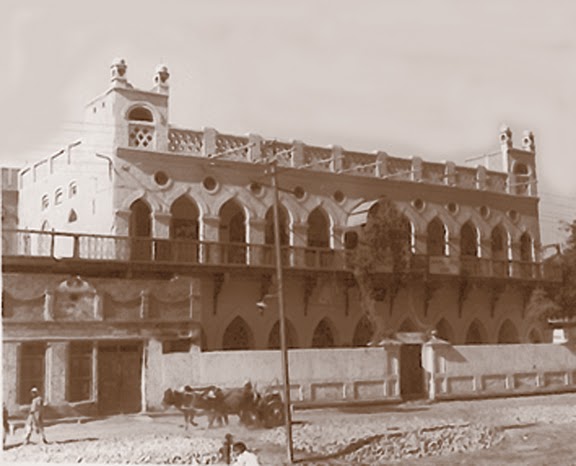
Piara Singh Padam (1978) in Mahatma Sant Rein mentions that the famous poet and Udasi priest Sant Rein established three deras in Halini (Sindh). I made enquires and found out that there were 4 deras at one time but only one exist now. This town in Naushahro Feroze district of Sindh has a famous Darbar dedicated to Udasi Saroop Das, built in late 18th century. Following partition in 1947, a Halani Darbar was established in Ajmer (Rajasthan).
Emergence of Sikhi & Sindh
Prior to the British occupation of Sindh, the Hindus were not allowed to purchase land and property. They could not ring bells and worship idols in the temples. The province of Sindh and Punjab are neighbours and Sikhi had a positive influence on the morale of Hindus. Malkani writes
"A significant factor in Hindu survival in Sindh during the Muslim period, in reasonably good shape, was the rise of Sikhism in the Punjab. Sanatan Dharma having gone moribund under prolonged Muslim rule, Sikhism came as a fresh breeze in the stale Sindhi atmosphere."
Migration of Multanis to upper Sindh
Bherumal Mahirchand Advani (1919) wrote that Amils (Administrators) left Multan and neighbouring areas in Punjab after 1666 during the reign of Mughal Emperor Aurangzeb. The Shikapuris (people of Shikarpur) who were renowned for their banking and business acumen are considered to be descendants of these people.
Some of them were Sikhs and others were influenced by the Sikh religion. As this migration happened before the establishment of Khalsa Panth in 1699, this may explain the 'non Khalsa' but Sikh tenants of Sindhis.
Manji & Masand
Dr Hari Ram Gupta has written that Guru Amar Das established 22 preaching centres called Manjis or cots on which a preacher sat to sing hymns to be followed in chorus by the Sangat (congregation). Bhai Lalu was the preacher for some parts of Sindh.
Guru Arjan refined and expanded the system into Masands (preachers) who did good work in propagating Sikhi. However after Guru Har Rai, these Masands became corrupt and hereditary and were disbanded by Guru Gobind Singh. Interestingly, I have been told by local Sindhis about the presence of Masand Deras in Bhavnagar (Gujarat). The place is run by Sehajdharis but have great reverence for Guru Granth Sahib which is recited with much devotion.
There are several Darbars (& even Mandirs) known as Khat Wari Darbars. I have located them in Khairpur (Sindh), Mumbai, Nashik among other places. Khat means cot and the preacher would sit on the cot. Their origin lies with Manji/Masand or Sevapanthis.
Bhai Dayal Singh
KR Malkani mentions a Khalsa Sikh, Bhai Dayal Singh who was sent to Sindh to fill martial spirit among the people. Sadly, I was unable to find more about Bhai Dayal Singh. Malkani writes "When Bhai Dayal Singh grew old in the service of the Guru's army, he was given a sword, a kirpan, a chakra, and a spear to go and infuse some courage in the Sindhis."
Bhai Kanhaiya
There is a strong tradition in Sindh that Bhai Kanhaiya, 'precursor to Red Cross' came to Sindh. It is said Bhai Kanhiya was sent to Sindh by Guru Gobind Singh. He came to be known as Khat Waro Bao (literal meaning in Punjabi is Manji wala Baba) because he gave his sermon while sitting on a cot. Surjit Singh Gandhi (1978) has written briefly on Bhai Kanhiya's journey to Sindh and his order Sevapanthis who propagated Gurbani in Sindh. Bhai Seva Ram, a follower of Bhai Kanhaiya established centres across Sindh to propagate Sikhi. The Khat Wari Darbar in Shikarpur commemorates the visit of Bhai Kanhaiya.
Gurdwaras built during Khalsa Raj
Malkani writes "Maharaja Ranjit Singh sent one Manik Singh with a copy of Guru Granth Saheb on elephant-back to be installed in Hyderabad. The Mirs gave land for the purpose and the well-known Akal Bhoonga was built there." The writer further states "The rise of Sikh power in the Punjab did come as a moral boost to the Sindhi Hindus, who had promptly put up a few gurdwaras."
After partition almost all Gurdwaras in Sindh were abandoned as all Sikhs and most Sindhi Hindus left for India. I was able to locate Akal Bhunga Road in Hyderabad (Sindh) but I have been informed that there is no remanence of the old Gurdwara. The present Sangat in Hyderabad have started the work to build a Gurdwara in the city.
The Sindhis (both Hindus & Sikhs) who came to India after 1947 built Gurdwaras in Maharashtra, Gujarat and Madhya Pradesh. Most of the present Gurdwaras in Sindh (Pakistan) have been built in the last 15 years.
Bandai Sikhs in Sindh
During my search on Sindhi (Khalsa) Sikhs, I came across Bandai Sindhi Sikhs. I spoke to Sardar Ratan Singh from Indore whose father came from Sindh to India after partition. I asked him about the status of Banda Singh Bahadur among his community and if he was considered as the 11th Guru. Rattan Singh clarified that Banda Singh Bahadur was a Sikh of Guru Gobind Singh and military leader of Sikhs. I asked the status of the head of Dera Baba Banda Singh Bahadur at Reasi near Jammu who is considered as descendant of the great Sikh general. He said Sikhs have only 10 Gurus and 11th Guru is Guru Granth Sahib. I did not push the issue further.
I asked him if they (Bandai Sikhs) married only among themselves. He replied that this was true but since past 20-30 years they marry among Sikhs. He volunteered and told me that unlike Punjabi Sikhs they are total vegetarian. (& I would add Keshdhari as well).
Dr Ganda Singh has mentioned that Baba Fateh Singh (of Dera Baba Banda Singh Bahadur) who was contemporary of Maharaja Ranjit Singh was given jagir by the former. Baba Fateh Singh took two extensive tours as far as Sindh (Larkana, Hyderabad etc.) to enlarge the Gurdwara Sahib in Reasi. Dr Ganda Singh further adds "There are signs to show that many Sikhs had gone towards Sindh and the south-western deserts and jungles of die Punjab during the perilous days that followed the death of Banda Singh."
Sant Thahriya Singh
 Chief Khalsa Diwan sent preachers to a number of places including to Sindh during early 20th century for the propagation of Sikh principles based on Gurbani. One local person who made much difference and is still revered by the Sindhi community in India and Sindh is Sant Thahriya Singh (d 1927) of village Kandhra, district Sakhra in Sind. His legacy continues and number of Gurdwaras are named as such 'Guru Nanak Darbar - Dera Sant Baba Thahriya Singh Ji. They should not be confused with any 'Deras' but it simply honours the name of Sant who brought Sindhis close to Sikhi. They have Gurdwaras in Pimpri (Pune), Gwalior, Indore (both in Madhya Pradesh), Bhavnagar Dhasa, Navsari, Palitana, Sihor, Dhola (all in Gujarat), Kota (in Rajasthan) and Malerkotla in Punjab.
Chief Khalsa Diwan sent preachers to a number of places including to Sindh during early 20th century for the propagation of Sikh principles based on Gurbani. One local person who made much difference and is still revered by the Sindhi community in India and Sindh is Sant Thahriya Singh (d 1927) of village Kandhra, district Sakhra in Sind. His legacy continues and number of Gurdwaras are named as such 'Guru Nanak Darbar - Dera Sant Baba Thahriya Singh Ji. They should not be confused with any 'Deras' but it simply honours the name of Sant who brought Sindhis close to Sikhi. They have Gurdwaras in Pimpri (Pune), Gwalior, Indore (both in Madhya Pradesh), Bhavnagar Dhasa, Navsari, Palitana, Sihor, Dhola (all in Gujarat), Kota (in Rajasthan) and Malerkotla in Punjab.
Sant Thahiriya Singh was a close associate of Sant Sham Singh (1803-1926) who performed kirtan seva at Harmandir Sahib for many decades and motivated numerous Sikhs during his lifetime including Sant Gurmukh Singh of Patiala (1849-1947) to take up Karseva of Gurdwaras. The combined efforts of these Gursikhs raise the number of Sikhs in Sindh from a mere 1000 in 1901 to 39,000 in 1941.
Present situation in Sindh
The Hindus in Sindh (& Pakistan) continue to live in a Muslim majority place and have mostly not been party to Arya Samaj/Hindu -Sikh tensions so they continue to hold Guru Nanak and Guru Granth Sahib in reverence. The heterodox belief and practices continues till today and for this reasons some people refer them to as Sehajdhari Sikhs. But it would not be correct to call all Sindhi Hindus as Nanakpanthis. In Upper Sindh, a minority of Sindhi Hindus who call themselves Gursikhs (Sikhs of the Guru) are Sehajdharis. They believe in Sikh Gurus and Guru Granth Sahib only. They do not undertake idol worship. Except for Kesh (or 5 Ks) they are Sikhs/Khalsa in every aspect. From these Gursikhs some have become Keshdhari and Amritdhari Sikhs, who now number about 10,000 in Sindh. Since 2005, these Sikhs have opened number of Gurdwaras (not to be confused with Udasi Darbars or Tikana) in every town and city of Upper Sindh.
The power of internet means that they can get access to keertan from Harmandar Sahib and Katha Vachaks from East Punjab. A small minority who calls themselves Gursikhs and Nanakpanthis by other Hindus are Sehajdhari Sikhs in real sense. Instead of Namaste, their salutation on meeting is Wahe Guru and the response is Dhan Wahe Guru or Wahe Guru Ji. Some of them have taken the next step in their spiritual journey and have become Khalsa. The majority of Sindhis is Pakistan reside in Tharparkar and Umerkot region. These people were historically and culturally part of Rajasthan but have been part of Sindh since 1750s. These people have no tradition of reverence for Guru Nanak (or Guru Granth Sahib in their culture). Relatively they are poor people and include tribes like Bheel and Koli, many are landless labourers. Sadly they are the forgotten people of Sindh.
As a sample of their diverse belief system, I am sharing a few short case studies of Sindhis across both sides of the border.
Case study - Ghotki (Sindh)
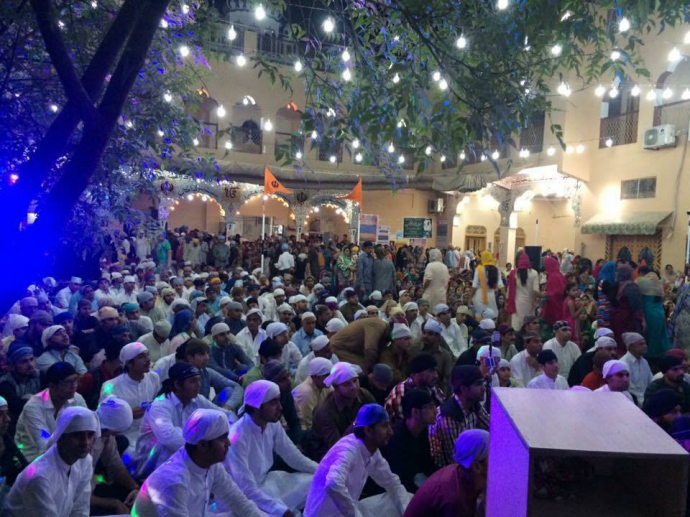
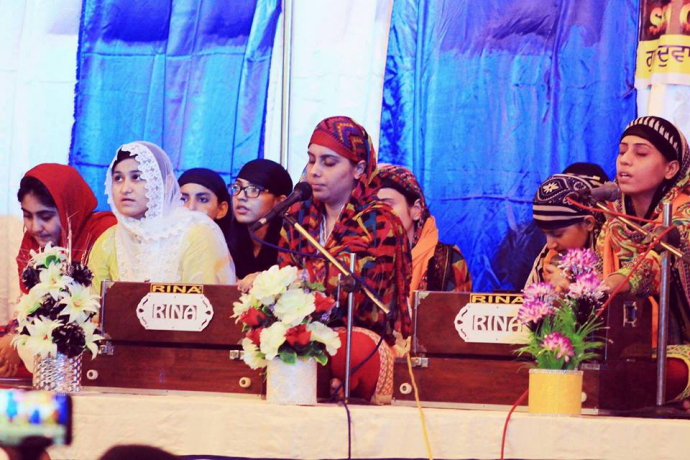
Ghotki is a city in northern Sindh and has a Gurdwara Guru Ram Das since 2005. I asked the Management Committee the number of Gursikhs in the town. He said about 250 who are part of regular Sangat (congregation). The Gurdwara Sahib held a 40 days evening Samagam (programme) to commemorate the martyrdom of Guru Arjan. The Samagam was concluded with Akhand Paathh which was conducted during last 3 days. I was told that daily there was a Sangat of about 500 people but during last three days the Sangat jumped to 5000 per day. When I asked him how many people (Hindus) in Ghotki have sharda (respect & reverence) for Guru Nanak? I was told, almost all. A similar answer was given to me in Shikarpur.
Case study - Pardeep
Pardeep is a young man living in Thatta district. He showed lot of enthusiasm while talking to me on Sikhi. Unlike North Sindh where there are number of people who could read Gurmukhi script, there are very few in interior and South Sindh. When I asked him if he was a Gursikh (Sehajdhari Sikh)? Pardeep said no but he is a Nitnemi (one who does Nitnem). He daily recites Jap Ji Sahib, Chaupai Sahib in the morning and Rehras Sahib & Ardas in the evening from a Gutka which is in Sindhi Persian/Arabic script.
Case study - Mrs Khatri
Mrs Khatri, a wife of expatriate in West Midlands told me that she has taken naam in Sanghar (interior Sindh). Following an Akhand Paathh, the hukamnama is given to person to recite and remember. When she was in Sindh she would go to Darbar and do seva for Sehaj Paathh of Guru Granth Sahib (in Sindhi script) near the Gurpurab of Guru Nanak. The bhog of Sehaj Paathh is conducted on the Gurpurab (birthday of Guru Nanak). I confirmed this from other sources.
Case study - Bhavnagar (India)
The city has about 300 Sikhs (half are Punjabis who are government employees on transferrable jobs and other half is Sindhi Sikhs). The city has 15 Gurdwaras only one was started by a Punjabi Sikh community, rest are run by Sindhis (who are about 35,000 and 70% of them go to Gurdwaras). Majority of the Sindhi wedding are conducted in Gurdwaras in Bhavnagar. Almost every year 2-3 Sindhi youth take Khande ka Amrit and become Khalsa. This is without any missionary influence but it is not surprising as many families are close to Sikhi. In Bhavnagar, one can easily distinguish a Punjabi Sikh to that of Sindhi Sikh. The former is a trimmer and goes to Punjab regularly. The latter is Keshdhari and in many cases Amritdhari. Sadly the Punjabis are generally poor adherent of the Sikh faith. Sindhis in Bhavnagar are definitely unique.
Present situation in India
The Sindhi Hindus in India have their own set of challenges. Unlike Punjab and Bengal, after partition of the country, Sindhis came to India but there was no Indian part of Sindh. They settled in neighbouring provinces of Rajasthan, Gujarat, Maharashtra and other places. As they are not a majority in any place, there can't be a Sindh province in India where they could implement Sindhi language. Hence the Sindhi language is less popular among new generation except where Sindhis are in appreciable numbers like Bhavnagar, Gwalior, Indore, Pune etc. Sindhi intellectuals have not been able to decide the script of their language. Some feel it should be devnagri (used for Hindi, Gujarati and Marathi) while other prefer Persian-Arabic script (as used in Sindh, Pakistan). Very few Sindhis in India can read Gurmukhi script. However, they continue to celebrate the Gurpurab of Guru Nanak with great fervour. Guru Granth Sahib continues to hold special place for them. But there are exceptions, Bhai Chela Ram's Ashrams gives almost similar exalted status to Guru Granth Sahib like in Gurdwaras. There are no idols of Hindu Gods and Goddesses in their Ashrams. Steven Ramey (2008) mentioned this in his famous work.
Conclusion
I have tried briefly to trace the history of Sikh relationship with Sindh. The three short case-studies give a flavour of diverse and heterodox beliefs of Sindhi Hindus in Pakistan. They are in some ways like Punjabi Hindus prior to 1947 that would read and recite Gurbani but would also participate in idol worship of Hindu God and Goddesses. The example of Bhavnagar in Gujarat is a unique and very interesting one. I have left readers to form their own conclusions from these case studies. My motive was to make both Sikhs and Sindhis aware of their historic relationship. We share a unique bond with them which should be preserved. It is not possible to cover everything in a short article. I have been researching on them for over 2 years now and hope to share more with the readers in the coming months.
‘Huge gathering of Sindhi Hindus at Amrit Vela in Ulhasnagar
Using earphones lest not to disturb others
Bhai Gurpreet Singh Mumbai Wale runs an Amrit Vela Trust in Ulhasnagar. He gives huge emphasis on Amrit Vela. You can see the big gathering of Sindhi Hindus in Ulhasnagar at Amrit Vela who are listening to his sermon/katha through earphones hence not disturbing the neighbouring areas.

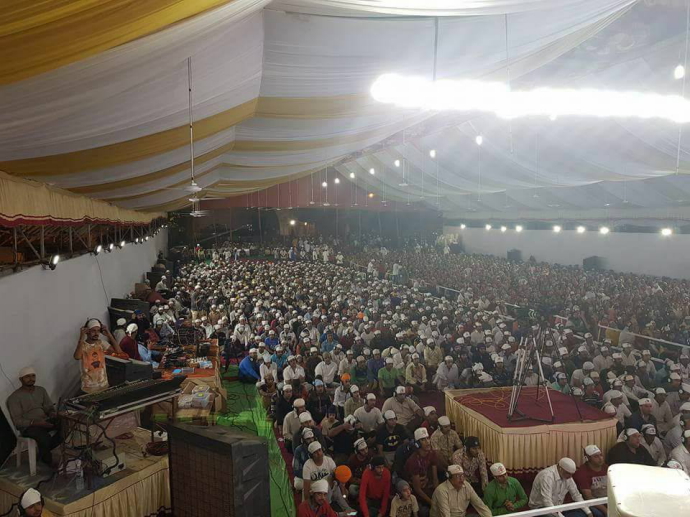
They have replaced loudspeakers with ear phones and still have Sadh Sangat and Amrit Vela Nitnem. The katha is in Hindi. The message of Guru Granth Sahib is not restricted by language. I wanted to show the big gathering of Sindhi Hindus and their ‘sharda’ (respect and love) towards Sikhi.
References
http://pakistanhinducouncil.org.pk/?page_id=1592 accessed on 29th May 2017 at 1020 hours
Burton, R.F (1851) Sindh & the races that inhabit the Valley of the Indus with notices of the topography and history of the province: London
Singh, K (2004) Janamsakhi Tradition, An Analytical Study. Amritsar: Singh Brothers
Bhai Bala Wali Shri Guru Nanak Dev Ji di Janamsakhi, (Punjabi) 39th Edition, Feb 2010 Amritsar: B. Chattar Singh Jiwan Singh
Malkani, K.R. (1997) The Sindh Story. Revised edition. New Delhi: Allied Publishers
Gandhi, S.S (1978) History of Sikh Gurus, A Comprehensive Study. Delhi: Gur Das Kapur & Sons
Advani, B.M (1919) A History of Amils (Translation of Amilan-jo-Ahwal) Hong Kong: Shamdasani Foundation 2016
Padam, P.S. (1978) Mahatma Sant Rein (in Punjabi) Patiala: Punjabi University
Nabha, K.S. (1930) Gur Shabad Ratnakar Mahan Kosh
Ramey, S. (2008) Hindu, Sufi, or Sikh Contested Practices and Identifications of Sindhi Hindus in India and Beyond. New Delhi: Palgrave Macmillan
Gupta, H.R. (1991) The History of the Sikhs Vol 1. Delhi: Munshiram Manohar Lal
Singh, G. (1935) Life of Banda Singh Bahadur based on Contemporary and Original Records. Amritsar: Khalsa College




